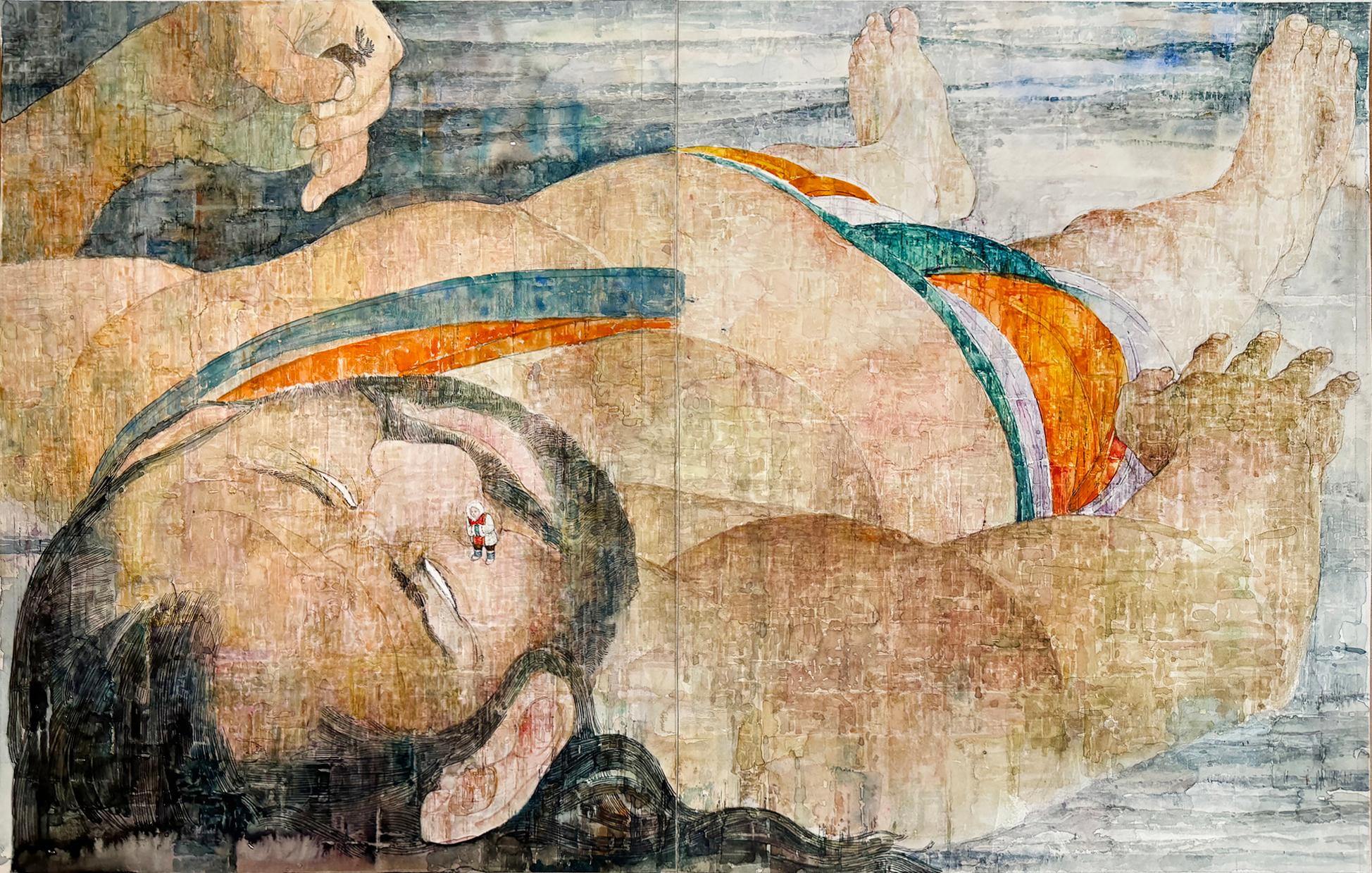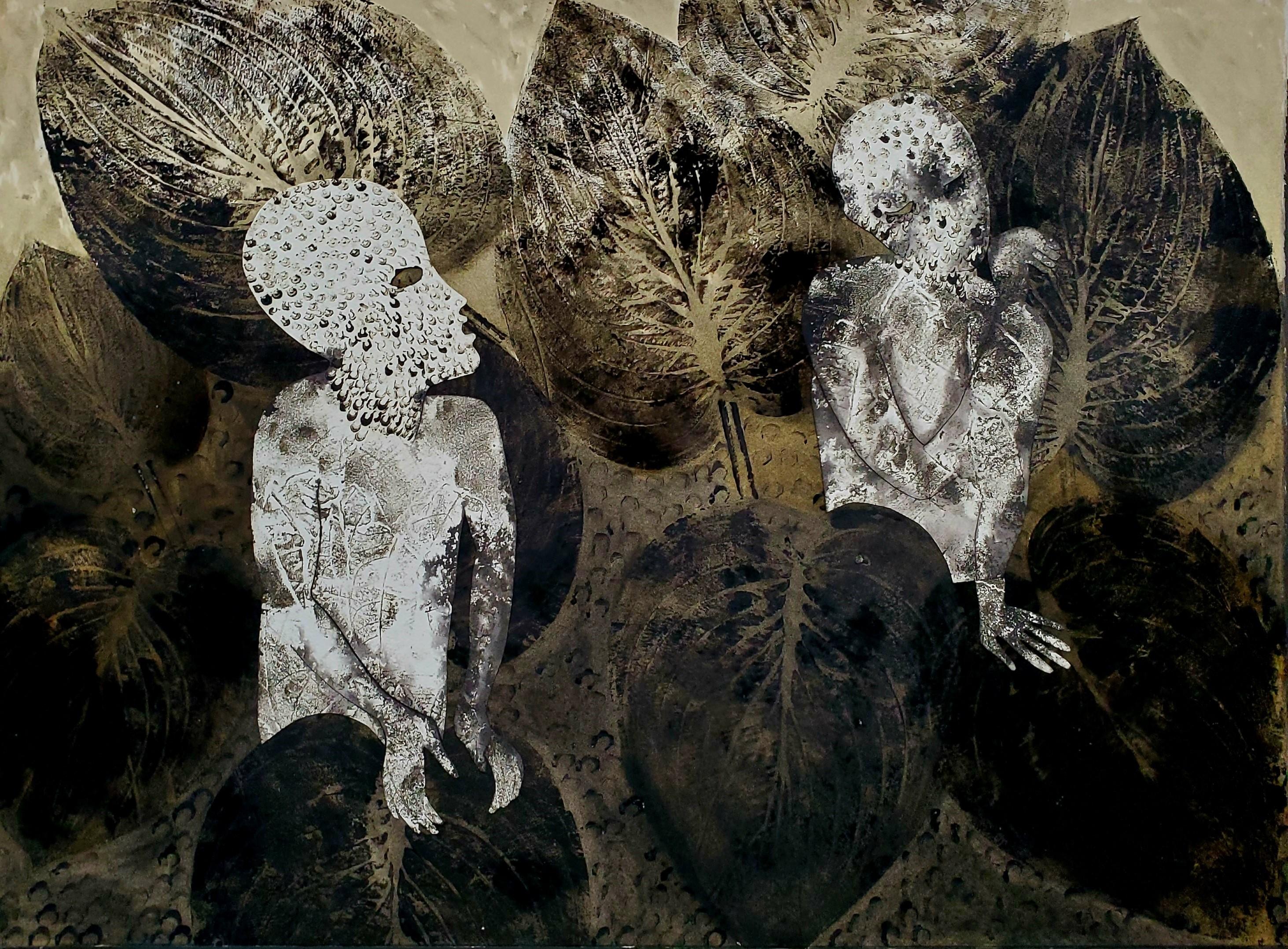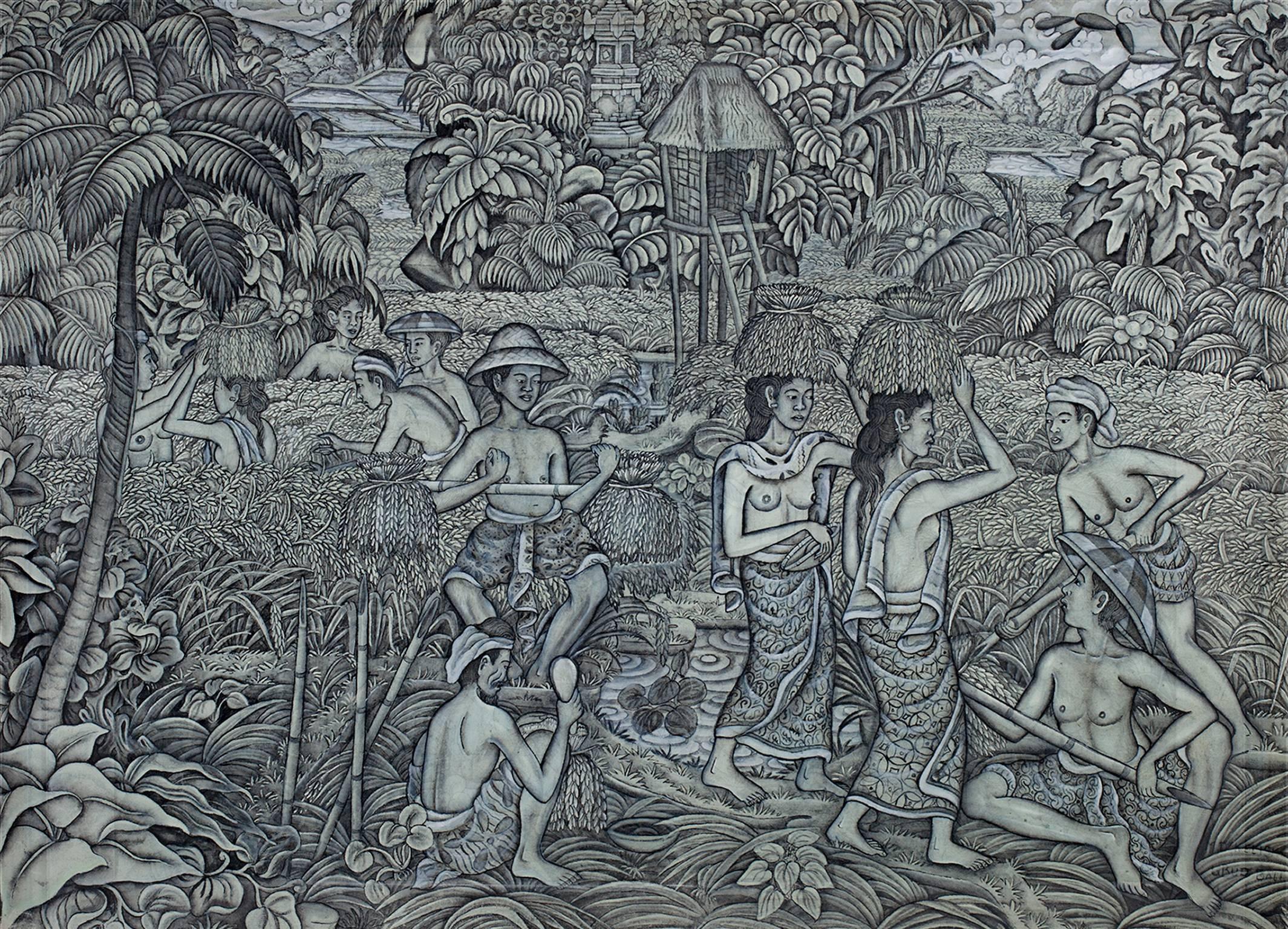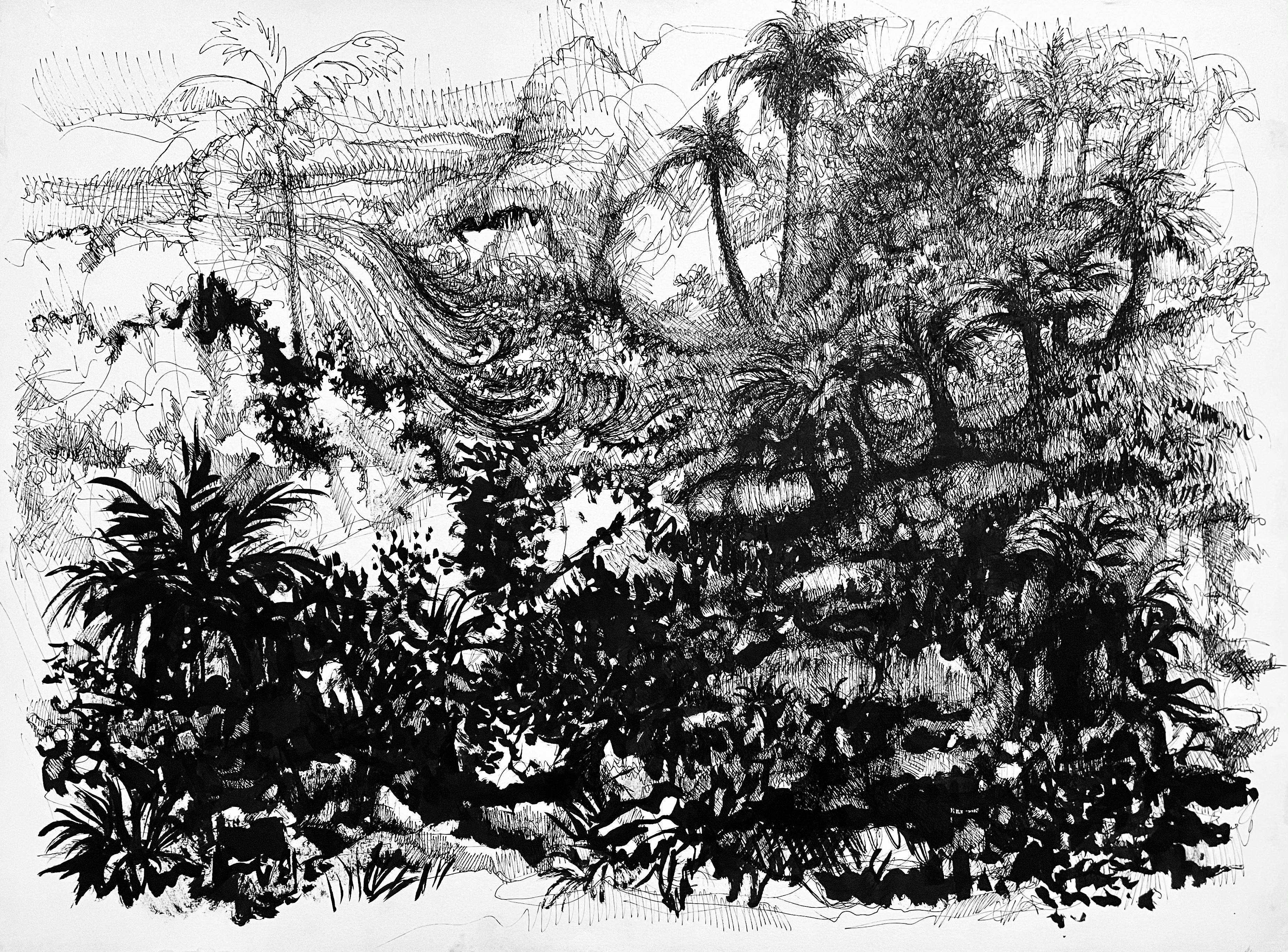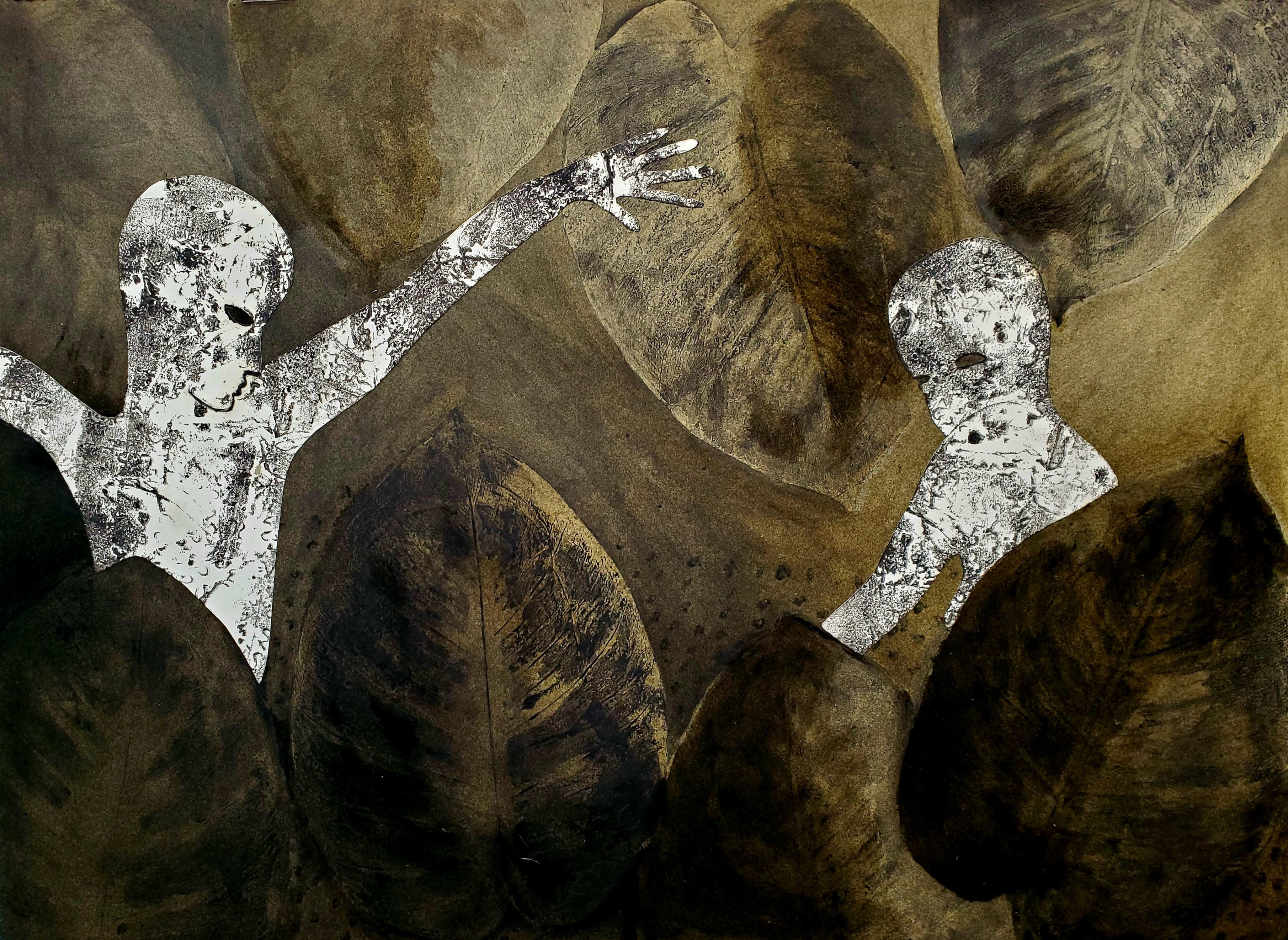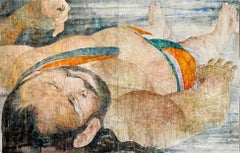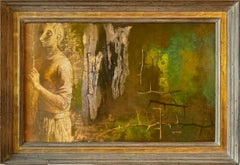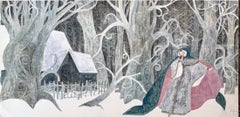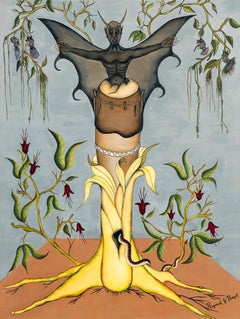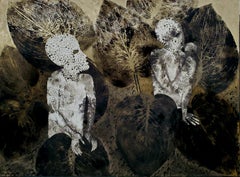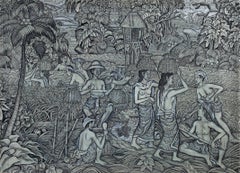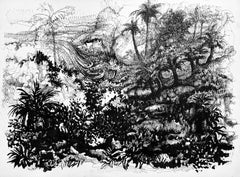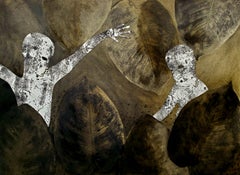Items Similar to Australian Aboriginal Fairy Tale in Jungle Scene Fantasy like Paul Gauguin
Want more images or videos?
Request additional images or videos from the seller
1 of 15
Gianni BenvenutiAustralian Aboriginal Fairy Tale in Jungle Scene Fantasy like Paul Gauguin1961
1961
$7,500
£5,643.05
€6,517.85
CA$10,599.46
A$11,502.03
CHF 6,095.06
MX$141,066.77
NOK 75,425.94
SEK 71,273.52
DKK 48,658.97
About the Item
Brilliant Italian Illustrator Gianni Benvenuti paints a moody fantasy that illustrates an Australian Fairy Tale. A young and fit Aboriginal man is scene chasing a beautiful Aboriginal maiden through an idyllic, dense primeval jungle. Two tropical parrots witness the scene as the man's hunt is interrupted by a flowing stream. As thin columns of light pierce the canopy, the artist flaunts his technical and aesthetic skills by designing a labyrinth trees in organic patterns of light and shadow making it as abstract as representation. Taking artistic liberty, Benvenuti places an oversized yellow orchid in front of the man to symbolize the scent of his feminine prey.
Unsigned and unframed. Conditon is very good. Published mid-century in an Italian Magazine.
- Creator:Gianni Benvenuti (1926 - 2005, Italian)
- Creation Year:1961
- Dimensions:Height: 13.5 in (34.29 cm)Width: 22 in (55.88 cm)
- Medium:
- Movement & Style:
- Period:
- Condition:Excellent.
- Gallery Location:Miami, FL
- Reference Number:1stDibs: LU385315777442

About the Seller
5.0
Gold Seller
Premium sellers maintaining a 4.3+ rating and 24-hour response times
Established in 2005
1stDibs seller since 2016
117 sales on 1stDibs
Typical response time: 1 hour
- ShippingRetrieving quote...Shipping from: Miami, FL
- Return Policy
Authenticity Guarantee
In the unlikely event there’s an issue with an item’s authenticity, contact us within 1 year for a full refund. DetailsMoney-Back Guarantee
If your item is not as described, is damaged in transit, or does not arrive, contact us within 7 days for a full refund. Details24-Hour Cancellation
You have a 24-hour grace period in which to reconsider your purchase, with no questions asked.Vetted Professional Sellers
Our world-class sellers must adhere to strict standards for service and quality, maintaining the integrity of our listings.Price-Match Guarantee
If you find that a seller listed the same item for a lower price elsewhere, we’ll match it.Trusted Global Delivery
Our best-in-class carrier network provides specialized shipping options worldwide, including custom delivery.More From This Seller
View AllSurreal Eskimo Fairy Tale - Indigenous People Folklore Story-Teller
Located in Miami, FL
This work celebrates the customs and folklore of Indigenous People / Eskimo native life. Illustrator Gianni Benvenuti shows a partially clothed Eskimo man lying on his back in a tran...
Category
1960s Surrealist Figurative Paintings
Materials
Tempera, Cardboard
Nature Walk Magic Realism in Dreamlike Setting
By Hazel Janicki
Located in Miami, FL
A soulful young man is captured in a deep, contemplative state, detached from current external concerns, as he gazes beyond the picture plane. He is realistically rendered, but the s...
Category
1960s Surrealist Figurative Paintings
Materials
Masonite, Tempera
Pushkin's Fairy Tales Princess - Fantasy Art - Art Nouveau
Located in Miami, FL
Italian Illustrator Gianni Benvenuti depicts a Pushkin's Fairy Tales Princess in a winter landscape of stylized trees with exaggerated curves and twisting branches. The princess is d...
Category
1960s Art Nouveau Landscape Paintings
Materials
Tempera, Illustration Board
Devil Emerges from Surrealist Voodoo Drum - Sans titre (Diable)
Located in Miami, FL
An image of a horned devil with pointy claws and bat-like wings emerges from a Voodoo drum. He has with arms stretched out like a Christ figure. The drum grows out of a yellow plant-...
Category
1970s Surrealist Figurative Paintings
Materials
Masonite, Oil
Arabian nights The Thousand and One Nights Gustaf Tenggren attrib. Scheherazade
By Gustaf Tenggren
Located in Miami, FL
This is a masterfully rendered and brilliantly designed scene from the Arabian Nights. page 33 from Random House. We are not sure if this is by Gustaf Tenggren. ( Gustaf Tenggren At...
Category
1650s Art Deco Figurative Paintings
Materials
Gouache
Princess and Prince, Hans Christian Andersen's Thumbelina Fairy Tales
Located in Miami, FL
Italian illustrator Gianni Benvenuti paints a charming fantasy scene. It's of an extreme closeup of a tiny crowned and winged Prince and Princess They are standing upright in a dand...
Category
1950s Surrealist Portrait Paintings
Materials
Gouache
You May Also Like
Lost paradises #5 Haude Bernabe Contemporary art Africa man in nature landscape
By Haude Bernabé
Located in Paris, FR
Mixed media on paper (oil paint and collage on paper)
Unique work
Haude Bernabé
“The road maps”
“During a stay in Togo in 2019, I was hiking in the bush and I discovered the dyein...
Category
2010s Contemporary Portrait Paintings
Materials
Paper, Oil
20th century figurative landscape tempera painting jungle forest scene signed
Located in Milwaukee, WI
"Rice Harvest" is an original tempera painting on canvas by an Indonesian artist. The signature may be "Kelishi" "M.D." or something similar and can ...
Category
Early 20th Century Folk Art Figurative Paintings
Materials
Canvas, Tempera
(Apocalyptic Tropical Landscape) Untitled
By Ian Hornak
Located in Fairfield, CT
Artist: Ian Hornak (1944-2002)
Title: Untitled (Apocalyptic Tropical Landscape)
Year: 1973
Medium: Ink on heavy archival paper
Size: 22 x 30 inches
...
Category
1970s Surrealist Landscape Drawings and Watercolors
Materials
Ink
$3,880 Sale Price
70% Off
Lost paradises #9 Haude Bernabe Contemporary art Africa man in nature landscape
By Haude Bernabé
Located in Paris, FR
Oil paint and collage on paper
Unique work
Hand-signed by the artist
Haude Bernabé
“The road maps”
“During a stay in Togo in 2019, I was hiking in the bush and I discovered the dy...
Category
2010s Contemporary Figurative Paintings
Materials
Paper, Oil
Lost paradises #1 Haude Bernabe Contemporary art Africa man in nature landscape
By Haude Bernabé
Located in Paris, FR
Mixed media on paper (oil paint and collage on paper)
Hand-signed and dated lower left by the artist
Unique work
Haude Bernabé
“The road maps”
“During a stay in Togo in 2019, I wa...
Category
2010s Contemporary Figurative Paintings
Materials
Paper, Oil
My African remix Haude Bernabé Contemporary art drawing work on paper nature
By Haude Bernabé
Located in Paris, FR
Watercolour on paper
Unique work
Hand-signed by the artist
Category
2010s Contemporary Figurative Drawings and Watercolors
Materials
Paper, Watercolor
More Ways To Browse
Fairy Tale
Vintage Maidens
Labyrinth Vintage
Fairy Paintings
Aboriginal Art
Vintage Jungle Art
Aboriginal Art Paintings
Vintage Jungle Painting
Jungle Landscape Painting
Fairy Tale Illustration
India Street Scene
Jane Levy
John Carlisle
John William North
Louis Vuitton Recto Verso Black
Middle Eastern Antiques
Mountain And Chalet Painting
Nancy Lund
